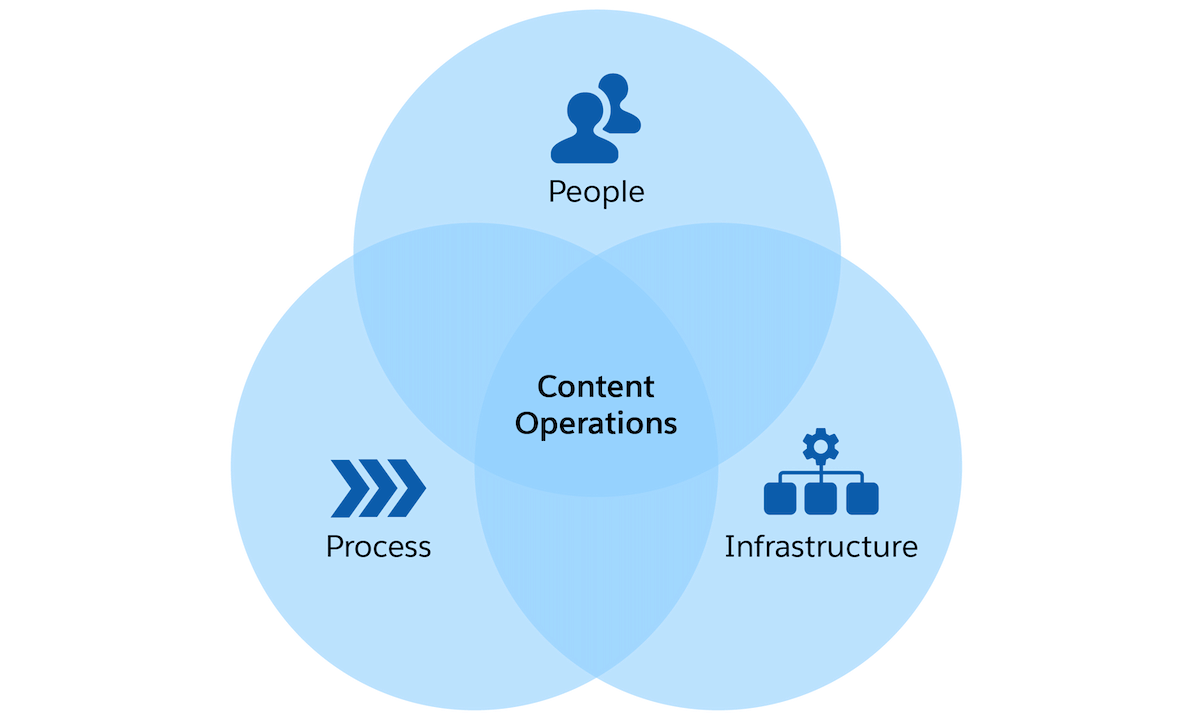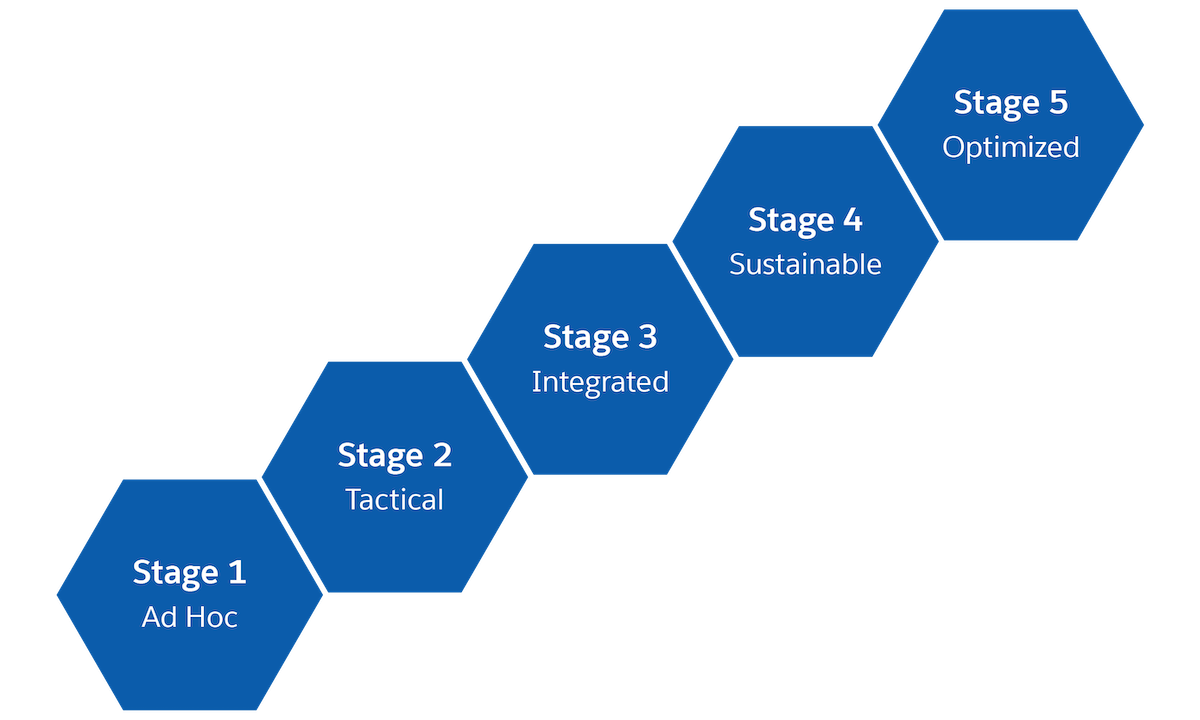Invest in Content Operations
Learning Objectives
After completing this unit, you’ll be able to:
- Define the term content operations.
- Explain the benefits of investing in content operations.
- Describe the five stages of content maturity.
From Strategy to Implementation
Creating content is hard. When you get it wrong, your customers can’t solve their problems or find the information they need. They get frustrated, confused, and overwhelmed. And that has real consequences: It can damage your brand and your business.
But when you get it right? It’s like a magic trick. You deftly anticipate your customers’ needs at each stage of their journey and deliver perfectly wrapped packages of content into their waiting hands—at exactly the right time and place. You delight your audiences, improve the customer experience, win new customers, and keep the existing ones.
So how do you craft effective and compelling content? Well, the first step is developing a rock-solid content strategy that guides all of your organization’s content efforts. (You learn how to do that in the Content Strategy Development module, so be sure to check it out.)
Once you have a content strategy, it’s time to implement it. And implementation is no small feat! You have to figure out how to produce and manage high-quality, on-strategy content in a repeatable, scalable way across multiple content teams—potentially across multiple brands and lines of business.
To do that, you need to start thinking about content operations.
What Is Content Operations?
Content operations refers to the people, processes, and infrastructure required to effectively produce and maintain content at scale.

Think of your organization as a machine that cranks out content. What powers that machine? What makes it possible to publish content? Every organization is different, but here are some of the most common elements of content operations.
| Component | Description |
|---|---|
|
People |
Content roles and responsibilities Content leadership Content governance Company culture Training and change management |
|
Process |
Content workflow Content guidelines and standards Content templates |
|
Infrastructure |
Content model and information architecture Content tools Content analytics |
Essentially, it’s all the behind-the-scenes work that goes into content development.
And here’s the thing: If your organization publishes any content at all, then you already have some form of operations in place. But if you take the time to improve and streamline your system for delivering content, then your organization can reap some pretty awesome benefits.
The Benefits of Content Operations
So why should you care about content operations? What advantages can be gained by investing in it? Here are the top benefits.
- Quality: Clearly defined workflows and guidelines help teams produce high-quality, consistent content.
- Speed and scale: Teams develop content at a faster pace when processes and infrastructure are streamlined, repeatable, and automated. And those operations can be scaled so that more people can produce larger volumes of content.
- Collaboration: Defining the roles and responsibilities of the people who produce content improves communication, transparency, and accountability. An enterprise-wide approach to content operations can break down silos between departments.
- Budget and resources: Building efficient systems for producing content saves money in the long run. It’s also easier to plan content and publish it on schedule when you know exactly what resources are needed and available.
- Value: With robust analytics in place, your organization can track the effectiveness of its content. Those insights help you refine your content strategy to provide more value to your audience and your business.
Of course, those benefits won’t materialize overnight. It takes time to build repeatable, scalable content systems. But the good news is that no matter where you stand today, it’s possible to reach a fully mature level of content operations.
A Content Maturity Model
As companies learn how to operationalize their content, they tend to evolve through five stages of content maturity. Let’s go over the characteristics of each stage so you can assess the maturity of your own organization.

Stage 1: Ad Hoc
- Content is created on a one-off basis, and it’s not managed or maintained.
- Content roles and processes don’t exist or they’re poorly defined.
- Executive leadership sees content as a cost center, not a business asset.
- Content creators don’t understand the customers’ needs.
- The effectiveness of content isn’t measured or analyzed.
Stage 2: Tactical
- Departments develop their own content plans and processes, but they work in silos with different agendas and objectives.
- Teams are tactical, not strategic. They focus on the project du jour (a product launch, a new feature, the latest campaign) and ignore the big picture.
- The organization measures rudimentary content analytics, like engagement metrics.
- Stakeholders begin to recognize the value of content after seeing positive results from tactical initiatives.
Stage 3: Integrated
- There’s voluntary cross-functional collaboration between the departments that create content.
- Content processes evolve and become more organized and repeatable.
- Teams have access to journey maps and personas so they can provide content that meets the needs of audiences across all touchpoints and channels.
- Content leadership begins to emerge.
Stage 4: Sustainable
- A centralized content strategy exists. Multiple teams create content, but they share a common vision.
- Teams follow uniform workflows and guidelines. Governance is established. Tools are improved and integrated.
- Content strategy aligns with the organization’s business objectives, and content effectiveness is tied to meaningful outcomes and KPIs.
- There is strong executive support for content.
Stage 5: Optimized
- The organization continuously invests in content innovation, customer research, and content intelligence.
- Leadership and stakeholders view content as a core competency that impacts the business and brand.
- An executive, such as a chief content officer, owns the content experience across all departments.
- Company culture encourages the creation and maintenance of high-quality, on-strategy content.
Keep in mind that different departments within your organization may have achieved different levels of content maturity. For example, perhaps the marketing and documentation teams are currently in Stage 3, but support and sales are in Stage 1. And that’s OK. More mature departments can share their ideas, success stories, processes, and technologies in order to cultivate content maturity across the entire organization.
Accelerate Your Content Maturity
So how do you turn your organization into a well-oiled content machine? Well, first you need an introduction to each element of content operations: people, process, and infrastructure. And hey! As luck would have it, that’s exactly what we cover in this Trailhead module.
Beyond that, there are four main factors that determine the pace of an organization’s content maturity process.
- Executive and stakeholder support
- Change management and company culture
- Cross-functional collaboration
- Commitment to piloting new processes and tools
It’s important to mention that there’s no shortcut to the final stage of content maturity. You can’t miraculously jump from Stage 2 all the way to Stage 5. But if you focus on the four factors above, it’s definitely possible to accelerate your progress.
Involve Your Content Stakeholders
Remember the content dream team you assembled in the Content Strategy Development module? Well, it’s time to round up those stakeholders and prime them for their new mission: figuring out how to implement your organization’s content strategy in a repeatable, scalable way.
Consider kicking off another round of discovery interviews to find out more about how content teams in your organization are currently handling content operations. That can give you insight into each department’s needs and challenges, and make it easier to implement an operational roadmap that everyone can support.
The Road Ahead
Ready to embark on your organization’s path to content transformation? Awesome! In the next unit, we turn our attention to the first element of content operations—the people in your organization.